For the past seven months I followed the 15 hour a week lesson plan from
The Natural Way to Draw. It has, with no exaggeration, changed my life. In this post I will attempt a summary of how this book improved my drawing ability. The basic idea behind the Natural Way to Draw is to break drawing down into simple acts of observation, and capturing that observation on paper. The exercises isolate these fundamentals and drill them in until they become second nature. Then later exercises "weld" these fundamentals into one cohesive drawing method. As you continue the exercises these fundamentals become natural, and you do them without even thinking about it.
Here is a sample of my drawing skill before The Natural Way to Draw.

It begins with contour and gesture drawing. The blind contour exercise forces you not to take your eyes off the model and draw with minimal looking at the paper. You move your eyes across the contour as if you were running your finger along it. The Natural Way to draw often mentions "touching" every part of your subject with your eyes.
Gesture drawing exercises are in every session throughout the course. I preferred moving subjects to still objects. I enjoyed going to busy parts of the city for people-watching and gesture drawing. When I didn't have time I would substitute TV, YouTube, or objects. In gesture drawing, you don't think, you just draw. I believe the amount of gesture drawing in this book is part of what makes the other techniques learned in the book second nature
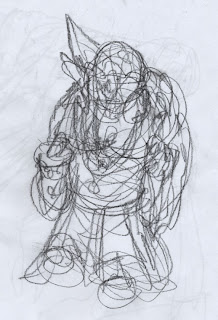
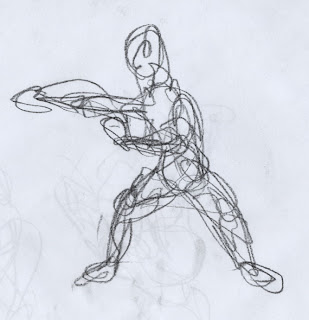
Cross contour is another great exercise in the beginning of the book. It helps train your eye to move across form.

Next is weight. In the first weight exercise you start by drawing the inside 'core' of the objects and draw your way out to the surface. In the next exercise you draw the surface of the object over the weight, making the parts that are further away from your eye darker. This is an exercise in modeling in lithographers crayon.
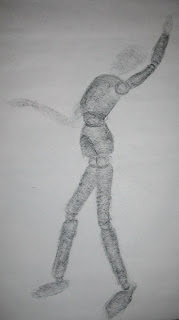
Next is modeling in pen and ink. This combines cross contour and modeling. I used a Bic ball point pen, and it was excellent. This is the point where I started to notice improvement in my drawing.
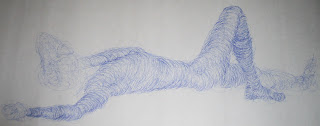
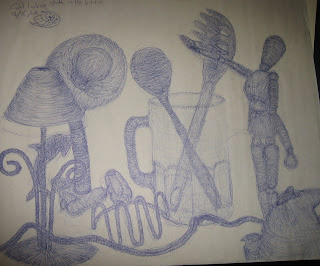
Next is modeling in watercolor. These water color exercises use 3 colors to make a simple gradation. You model with different tones instead of by applying more or less pressure.
Two weeks of drapery study are in the middle. Here, drapery hung from a wall is rendered in three parts, White being the top of a fold, medium gray being the sides of the fold, dark grey being the area flat against the wall. Drapery is also studied in gesture and contour studies.
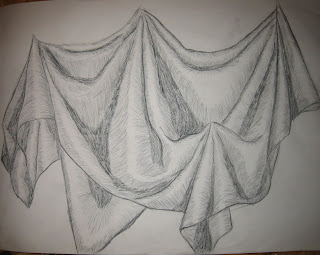
About half way through the book, gesture, contour, and modelling are "welded" into one drawing composed of three drawings, the sustained study. First is an extended gesture of the model, next is a contour drawing is drawn on tracing paper over the gesture, a modelled drawing is drawn on tracing paper over the contour. This basic prossess is repeated in the rest of the book with clothed and nude models. Later the sustained study is further built up by first adding light and shade to the modeling (as opposed to parts that are further away rendered darker). Then it is done in black and white conte crayon, black and white oil, and finally full color.


Anatomy drawing exercises are also common later in the book. I posted some of these earlier. In these exercises, bones and muscles are drawn on tracing paper over earlier drawings.



The final exercises in the book are supposed to be done in oil. I replaced oil with photoshop, because I will be continuing in digital mediums and not oil. Gesture drawings became five minute black and white studies in gesture style.
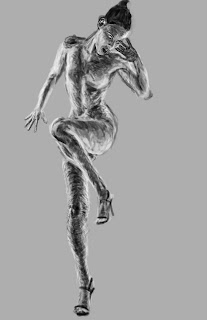
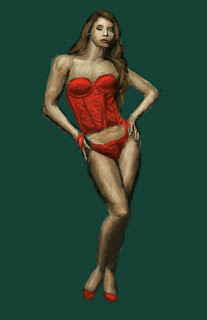


This is just a brief summary to give you the basic idea of the book, and what helped me the most. Obviously there is a lot more in the book, more than I can fit in a post. So go check it out for yourselves. I swear I am not being paid for this by the publisher.
After doing the $100,000 Drawing Course and Before starting the Natural Way to Draw, I had no structure to my study and I could tell I was not improving. Not only did the Natural Way to Draw tighten my skills, but it gave me a working plan to continue my study. I plan to continue using the 15 hour a week schedule with some of the same exercises and some knew ones.
 Two Color Gesture - This is the same exercise as the 5 minute black and white gesture. Except now I use two analogous colors instead of black and white. Its good for getting used to the way colors mix in Photoshop. Its a color warm-up
Two Color Gesture - This is the same exercise as the 5 minute black and white gesture. Except now I use two analogous colors instead of black and white. Its good for getting used to the way colors mix in Photoshop. Its a color warm-up
 Cartoon Gesture - These are quick copies from still-framing classic cartoons. I start by quickly drawing the basic forms, then I go back over and quickly draw the contour lines. Gesturing human figures really helped to ingrain human proportions and movement. I am hoping this does the same for cartoon characters. This week I used Looney Tunes.
Cartoon Gesture - These are quick copies from still-framing classic cartoons. I start by quickly drawing the basic forms, then I go back over and quickly draw the contour lines. Gesturing human figures really helped to ingrain human proportions and movement. I am hoping this does the same for cartoon characters. This week I used Looney Tunes.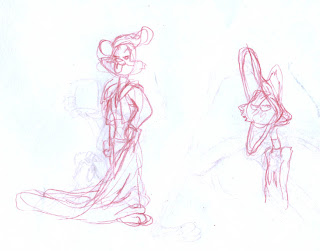


 Under Painting - In this exercise, I experimented with under-painting technique and using layers in Photoshop. I did a quick rendering of the model in two colors and then used a thin layers of photoshop paint over it to change the colors.
Under Painting - In this exercise, I experimented with under-painting technique and using layers in Photoshop. I did a quick rendering of the model in two colors and then used a thin layers of photoshop paint over it to change the colors.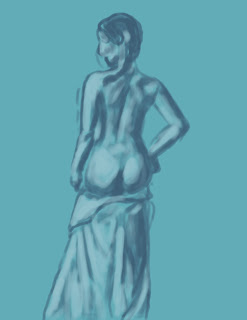
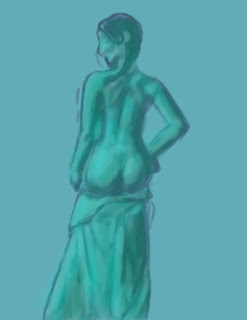
 Structure Studies - This quick exercises is to break down a figure into simple shapes. First I break down the figure into basic shapes by drawing the shapes over the figure on another layer. Then I draw the shapes in my sketch book. I beleive this exercise will help me in drawing realistic figure quickly, without a model for reference.
Structure Studies - This quick exercises is to break down a figure into simple shapes. First I break down the figure into basic shapes by drawing the shapes over the figure on another layer. Then I draw the shapes in my sketch book. I beleive this exercise will help me in drawing realistic figure quickly, without a model for reference.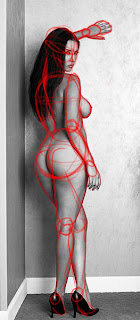
 Sustained Study - Still Life - This is the same as the sustained study in The Natural Way to Draw except using a still life instead of a model. I chose this still life to gain more experience in using color.
Sustained Study - Still Life - This is the same as the sustained study in The Natural Way to Draw except using a still life instead of a model. I chose this still life to gain more experience in using color.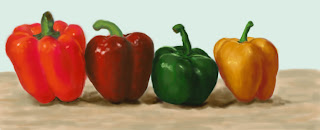 Overall I am very happy with my progress this week. I have increased my understanding and ability to paint in full color in photoshop. That was the goal of this weeks exercises, and that is what they did.
Overall I am very happy with my progress this week. I have increased my understanding and ability to paint in full color in photoshop. That was the goal of this weeks exercises, and that is what they did.

















